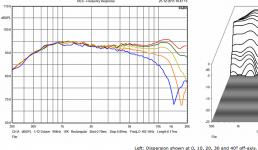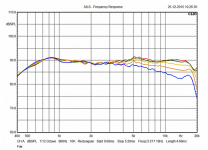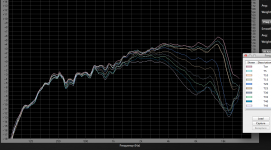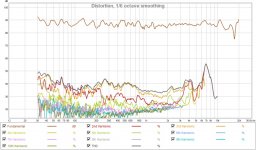Looks very promising......and the ADC has even lower distortion values. If we're really talking bookshelf/nearfield use i can't see a reason to consider anything greater than 100db.
The RDC usually has a rough response above 10khz on larger waveguides for some reason...might be wavefront interaction with the large surround
The RDC usually has a rough response above 10khz on larger waveguides for some reason...might be wavefront interaction with the large surround
The sims assume pistonic motion, so all cone breakup effects are not represented. The little waveguide thing on the ADC may have to be removed. If you limit to 100dB, there is a lot of room to EQ the response to suit, so it may work. I am not sure I like -30dB HD at 600Hz though. -40dB to -45dB would be preferable - that is what the SB65 gets and I would trade that for the smoothness you may get with the 1in domes in the upper end.
Sure, I can print and adapter and stick it on the LTH142 horn and see what I get. PM me and we can work out details.
I have an RDC on hand if you wanna mess with it.
Sure, I can print and adapter and stick it on the LTH142 horn and see what I get. PM me and we can work out details.
The RDC has a soft dome, the VHF is radiated from the outside, near the voice coil. It actually has more narrow dispersion than the 3.5" TC9.Looks very promising......and the ADC has even lower distortion values. If we're really talking bookshelf/nearfield use i can't see a reason to consider anything greater than 100db.
The RDC usually has a rough response above 10khz on larger waveguides for some reason...might be wavefront interaction with the large surround
The ADC dome is more pistonic, dispersion is much wider, as well as having more Xmax.
Attachments
Last edited:
How about a Transducer Labs tweeter? They seem to work superbly in waveguides, probably due to their low/flat domes and they have small surrounds but at the same time large xmax (0.5 mm). Maybe a dome requires a too large waveguide angle to work in synergy type speakers?
I definitely want to see the 29RDC as that really could work. The R2604 ringradiator obviously works in deep waveguides, so why not?
/Anton
I definitely want to see the 29RDC as that really could work. The R2604 ringradiator obviously works in deep waveguides, so why not?
/Anton
Hi, this is Horn.ell.a website: SpeakerLAB srlSorry, never even heard of it. Do you have a link to where it is found/described?
I use Akabak and see no reason to try or learn another program at this point.
OK guys - took a few moments out from my listening to do some distortion sweeps of the second speaker I made - I am a little worried by an odd peak in the HD at 7000Hz.
I just wonder if I have a faulty driver - should have done some sweeps before installing it!
It is a narrow spike which isn't present on the other SB65 and is -35dB down - so extremely likely to be inaudible - but if I could solve it, I would like to. I have tried relaxing the screws in case I had overly tightened it down.
It doesn't seem to be broadband in nature so I don't think it is rubbing of the surround or a mechanical problem. It is also present when taken off the horn.
I just wonder if I have a faulty driver - should have done some sweeps before installing it!
It is a narrow spike which isn't present on the other SB65 and is -35dB down - so extremely likely to be inaudible - but if I could solve it, I would like to. I have tried relaxing the screws in case I had overly tightened it down.
It doesn't seem to be broadband in nature so I don't think it is rubbing of the surround or a mechanical problem. It is also present when taken off the horn.
Attachments
Bushmeister, does an impedance test of the separate speaker show anything at that frequency?
By the way, as this thread is the first place where I asked you guys to do EQ-ing based on REW's Frequency Dependant Window I'll let you know I found out that it isn't a high resolution view. I notice clear differences if I extract the same data in DRC-FIR.
I made a post on my thread, but to me it's clear I have a preference for DRC from this point on when talking about frequency dependant windows (FDW).
I did not know the difference to be this big. The example I show isn't the best or the most telling, I'll show a better one soon. The post: 5 cycle window comparison between REW and DRC-FIR
At least the statement that you won't overcorrect using REW's window is correct and this doesn't mean the results are rubbish. REW's window looks smoothed, but is also deviating from DRC in my example.
Though I should let you guys know! Sorry 🙂.
By the way, as this thread is the first place where I asked you guys to do EQ-ing based on REW's Frequency Dependant Window I'll let you know I found out that it isn't a high resolution view. I notice clear differences if I extract the same data in DRC-FIR.
I made a post on my thread, but to me it's clear I have a preference for DRC from this point on when talking about frequency dependant windows (FDW).
I did not know the difference to be this big. The example I show isn't the best or the most telling, I'll show a better one soon. The post: 5 cycle window comparison between REW and DRC-FIR
At least the statement that you won't overcorrect using REW's window is correct and this doesn't mean the results are rubbish. REW's window looks smoothed, but is also deviating from DRC in my example.
Though I should let you guys know! Sorry 🙂.
OK guys - took a few moments out from my listening to do some distortion sweeps of the second speaker I made - I am a little worried by an odd peak in the HD at 7000Hz.
I just wonder if I have a faulty driver - should have done some sweeps before installing it!
It is a narrow spike which isn't present on the other SB65 and is -35dB down - so extremely likely to be inaudible - but if I could solve it, I would like to. I have tried relaxing the screws in case I had overly tightened it down.
It doesn't seem to be broadband in nature so I don't think it is rubbing of the surround or a mechanical problem. It is also present when taken off the horn.
That's a overly tight screw on the SB65.
He just wrote he tried relaxing the screws, and the distortion is also present when taken off the horn, so the screws are not the screw up this time.That's a overly tight screw on the SB65.
Could be a bit of debris in the gap, or just a difference within quality control standards.
He just wrote he tried relaxing the screws, and the distortion is also present when taken off the horn, so the screws are not the screw up this time.
Yes, I missed that - hard to see sometimes when I read it on my phone. Given that it is present even when of the horn, that is a defective driver or maybe debris, or a misaligned frame/voice coil.
Cheers guys, I will take it out give it a good clean and see if I can improve it. If not I will order a new one.
Anyone have any top tips on sorting out issues like this? Should I try running it at near Fs to see if some high excursion will sort it?
It's sad exstra work but i would take both of them out so as to have a working reference under various tests, myself have three brand new of those laying around so request if you like any data from DATS device or REW.
Brytt you are a star! Could you just do a quick distortion sweep at 30 cm, naked driver around 90dB?
Just to give me an idea of the levels to expect. Thanks so much. I know your way is the right way - but hate the idea of ripping them both down - so will just pull the defective driver first!
Cheers,
Just to give me an idea of the levels to expect. Thanks so much. I know your way is the right way - but hate the idea of ripping them both down - so will just pull the defective driver first!
Cheers,
.....Could you just do a quick distortion sweep at 30 cm, naked driver around 90dB?.....
After job will post setup.
By the way, as this thread is the first place where I asked you guys to do EQ-ing based on REW's Frequency Dependant Window I'll let you know I found out that it isn't a high resolution view. I notice clear differences if I extract the same data in DRC-FIR.
I've been saying that all along, at least in regards to the use of the fdw in REW [emoji6]. X proved that with his comparison a couple weeks ago.
I wonder what's different with the way that the DRC sw does it?
I've been saying that all along, at least in regards to the use of the fdw in REW [emoji6]. X proved that with his comparison a couple weeks ago.
I wonder what's different with the way that the DRC sw does it?
I know you mentioned longer windows. But the same 5 cycle length window in DRC just gives way more detail. I want the FDW as short as it is, for speaker correction and not use it as room correction at mid frequencies and up. And not just because I happen to measure at the listening spot.
Here's a graph that shows a little comparison:
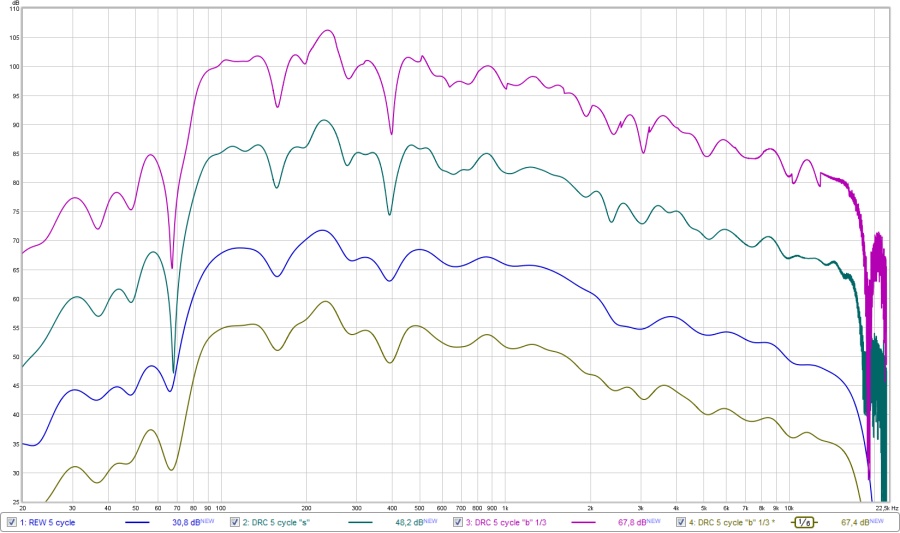
I used 2 different methods of FDW in DRC, that's the top 2 graphs. (I prefer and use the second)
The third is REW's FDW, also set to 5 cycles like DRC
The fourth is the top DRC graph smoothed 1/6 octave. That comes pretty close to what REW "sees".
But DRC isn't a measurement suite and there will be differences. Normally you wouldn't see this output stage. But this is the frequency dependant window I use (well, actually mine is still a bit different as it's not one fixed value). REW's version is heavily smoothed in comparison.
It seems based on similar technology as the 1/3 octave steps method as presented in the top DRC graph. The second from the top is a sliding window, no real steps. You can even adjust it further in resolution by setting some parameters.
I assumed there was a difference, but it would be negligible. That's not the case. You're bound to miss vital information with REW's window implementation. I wouldn't advice making the window in REW longer (in cycles) to make up for that. That would miss the point of using this type of windowing in the first place.
Last edited:
I will have to wait for the more detailed instructions on what FDW I should be using then. However, given that the 1/6th octave may not be ideal in REW, it still, nonetheless has produced some nice results for the EQ'ing that both Bushmeister and I have performed thus far. I still add some manual tweaks afterwards - but very small ones.
wesayo - I'm saying to use a fixed gate before the first reflection. With the typical first reflection (doing the best we can in a room to minimize this) you're only really doing speaker correction over 1khz or so with the fdw (if it's set correctly)....and heavily smoothed at that. Below 1khz it's speaker+room correction unless you're using a ridiculously low number of cycles In which case the data will be so heavily smoothed that it's near worthless.
I still contend that the fdw is really only useful for getting an idea of what we hear at the lp.......not for actual hi-res quasi-anechoic speaker measurements. I *will* use the fdw when doing speaker/xo work to get an idea of the level below 1khz which is obscured by a short gate, but I'm not using it for eq at that point.
I still contend that the fdw is really only useful for getting an idea of what we hear at the lp.......not for actual hi-res quasi-anechoic speaker measurements. I *will* use the fdw when doing speaker/xo work to get an idea of the level below 1khz which is obscured by a short gate, but I'm not using it for eq at that point.
- Home
- Loudspeakers
- Multi-Way
- A Bookshelf Multi-Way Point-Source Horn
